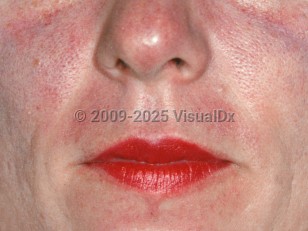Functional tumors produce biogenic amines and peptides such as serotonin (5-hydroxytryptamine [5-HT]), bradykinin, tachykinins, histamine, and prostaglandins. The symptoms and signs associated with carcinoid tumors vary according to which biogenic amines and peptides are secreted as well as the location of the tumor.
Carcinoid syndrome comprises the presence of cutaneous flushing, diarrhea, abdominal pain, wheezing, and palpitations. It is usually seen in the setting of an ileal tumor that has metastasized to the liver. Lung carcinoid may also be responsible. Carcinoid syndrome can occur at any age, but the mean age is between 60 and 70 for tumors of the small intestine and rectum. 5-HT is thought to cause the diarrhea and cardiac complications, whereas bradykinin, a vasodilator, produces cutaneous flushing, bronchospasm, and increased intestinal motility. Carcinoid heart disease arises as the circulating vasoactive substances cause the tricuspid and pulmonary valves to become fibrotic, resulting in pulmonary stenosis and tricuspid incompetence. Less commonly, the mitral and aortic valves may be affected, typically in patients with patent foramen ovales. The prognosis for patients with carcinoid syndrome is better if there is no concomitant carcinoid heart disease.
Carcinoid crisis is a life-threatening complication of carcinoid syndrome. The crisis is caused by an excessive release of serotonin and other chemicals, such as histamines. It is characterized by the sudden onset of prolonged cutaneous flushing, peripheral cyanosis, confusion, dyspnea, and tachycardia. This condition may be triggered by stress, chemotherapy, anesthesia, hypothermia, or hypertension, and may even occur without any apparent triggers.
The cutaneous manifestations of carcinoid tumor in general include the following:
- Flushing
- Skin changes related to niacin deficiency, which leads to a pellagra-like dermatitis
- Scleroderma-like skin changes
- Cutaneous metastasis
The time period between onset of symptoms and diagnosis varies based on the location of the tumor and associated symptoms. Asymptomatic tumors are usually discovered incidentally during surgery.
Related topic: noncarcinoid flushing



